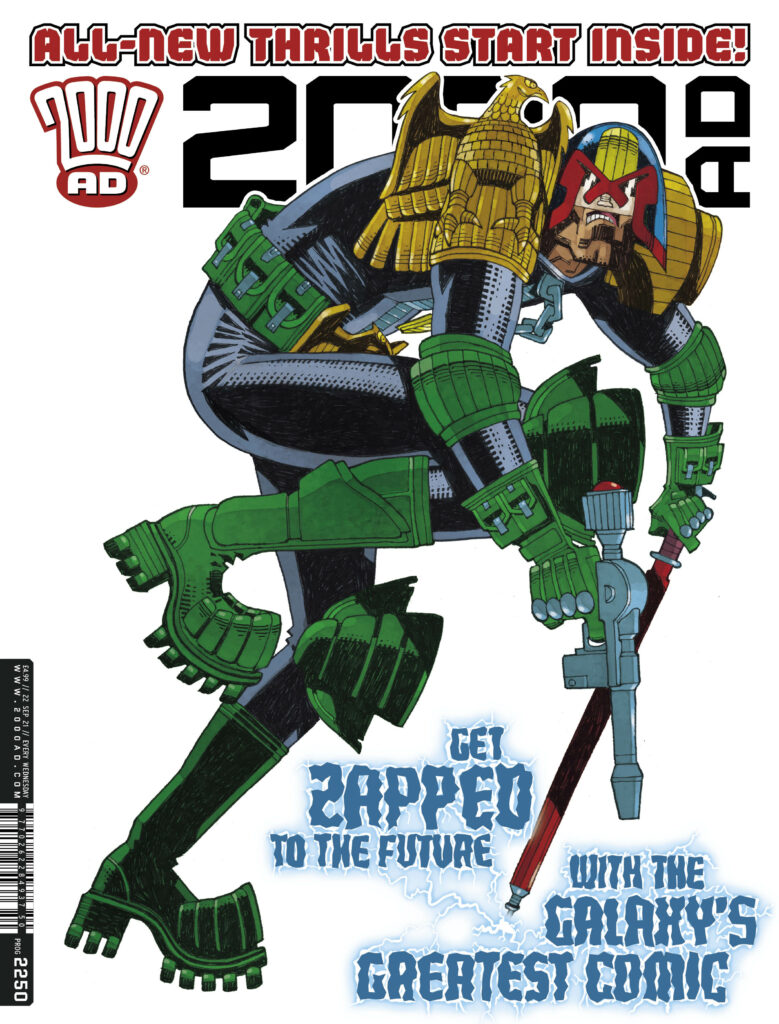Interview: Ian Edginton & D’Israeli are at the Storm Front! Next stop – Jupiter!
23rd September 2021
Part of the excitement with 2000 AD Prog 2250, the next jumping-on Prog that Tharg is sending your way, is the return of the long-running and quite brilliant Scarlet Traces series from Ian Edginton and D’Israeli, which launches into the new series, Storm Front.
If you don’t know – and seriously, you’re missing out – Scarlet Traces is all about taking the ideas of HG Wells’ War of the Worlds and spinning out a vast, enthralling steampunk sci-fi epic that all began ten years after the abortive Martian invasion of Earth, with Britain truly ruling the world with reverse-engineered alien technology.
As the series have moved on, time has passed and Britain’s foremost position as a world power has gone, as it finds itself outpaced by its rivals and struggling to cope with the millions of Venusian refugees fleeing the Martian invasion of their planet.
At the conclusion of the last series, Scarlet Traces: Home Front, in Prog 2138, we were deep into the amazing tale, following the Royal Air Force’s Ahron Shakespeare, first-generation Earth-born Venusian, and the flamboyant human/Martian hybrid, Iykarus, as they get ready to go to war…
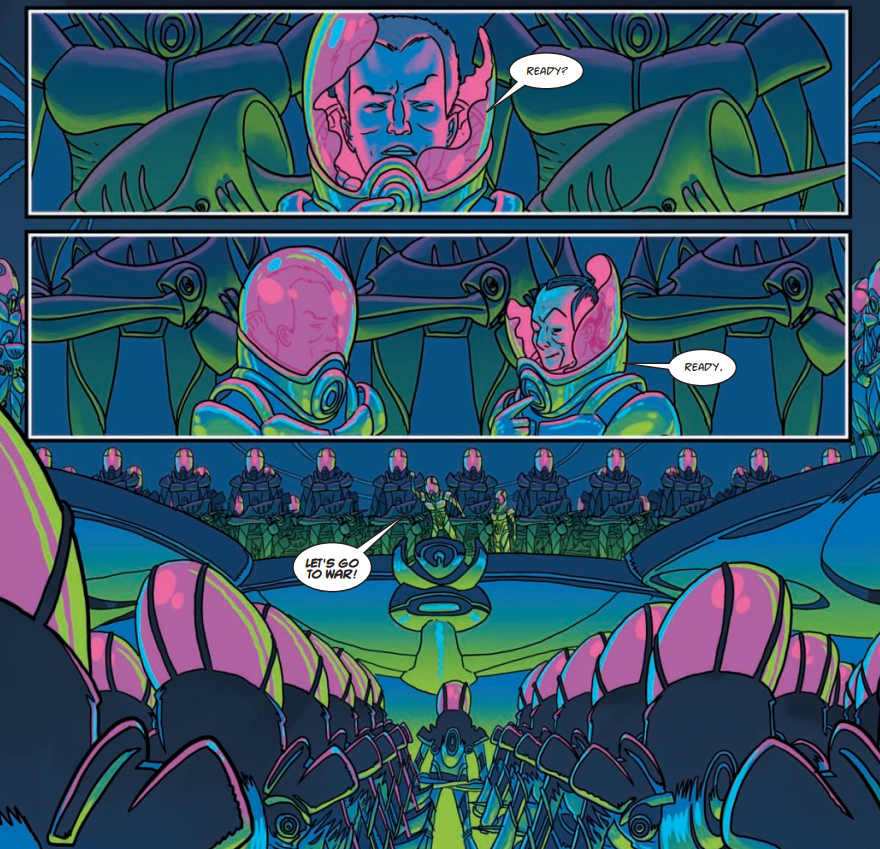
.
We’ve got a fascinating interview with Ian Edginton and D’Israeli (Matt Brooker) for you, with the first part all about Ian and Matt chatting about Scarlet Traces: Storm Front and what to expect, and then we have a real treat for you, as D’Israeli took the time and trouble to send over the process images for the stunningly psychedelic double-page spread that’s the highlight of Storm Front part one!
So, with Scarlet Traces: Storm Front, where will the Edginton & D’Israeli team take us? What terrors await? Well, the best people to talk to about that would be the ever-wonderful Ian Edginton and D’Israeli, d’emon draughtsman themselves!
One thing’s for sure though, if you’re expecting to see war erupt from the very first page, given that ending to Home Front, Edginton and D’Israeli have other, far more fascinating plans. Here’s how Storm Front opens up…
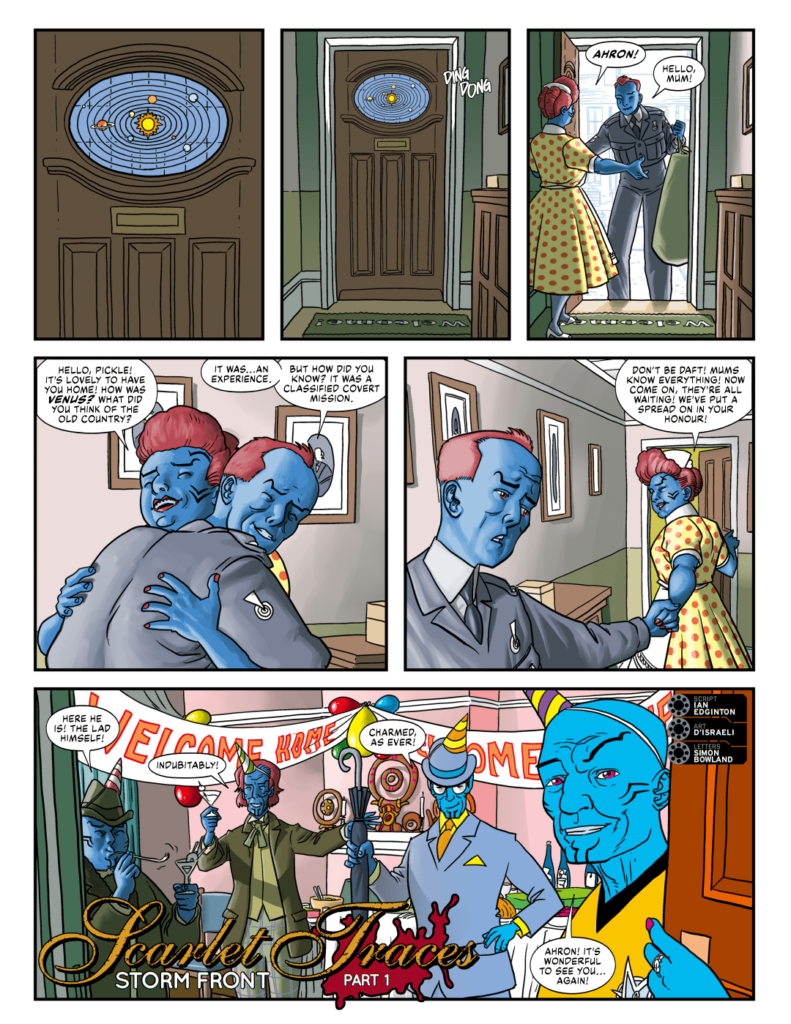
.
We’re deep into the storyline of Scarlet Traces here with Storm Front, so I suppose the first thing to do is get you to give us some kind of story so far and where you’re going with Storm Front?
IAN EDGINTON: In the previous series we witnessed the overthrow of the Martians’ occupation of Venus and a spanner thrown in the works of their plan to disassemble the solar system and build a Dyson sphere-style habitat around the Sun. They’re now looking to take out their revenge on the Earth once more.
Meanwhile our heroes Ahron and Iykarus have recruited the reclusive Jovians (inhabitants of Jupiter) to help the Earth in her hour of need. It’s also been revealed that the Martians have reached a genetic dead-end, their numbers have dwindled drastically, this is the last stand for them as well. Phew!
How many episodes do we have to look forward to with this one?
IE: It’s a snug twelve-parter.
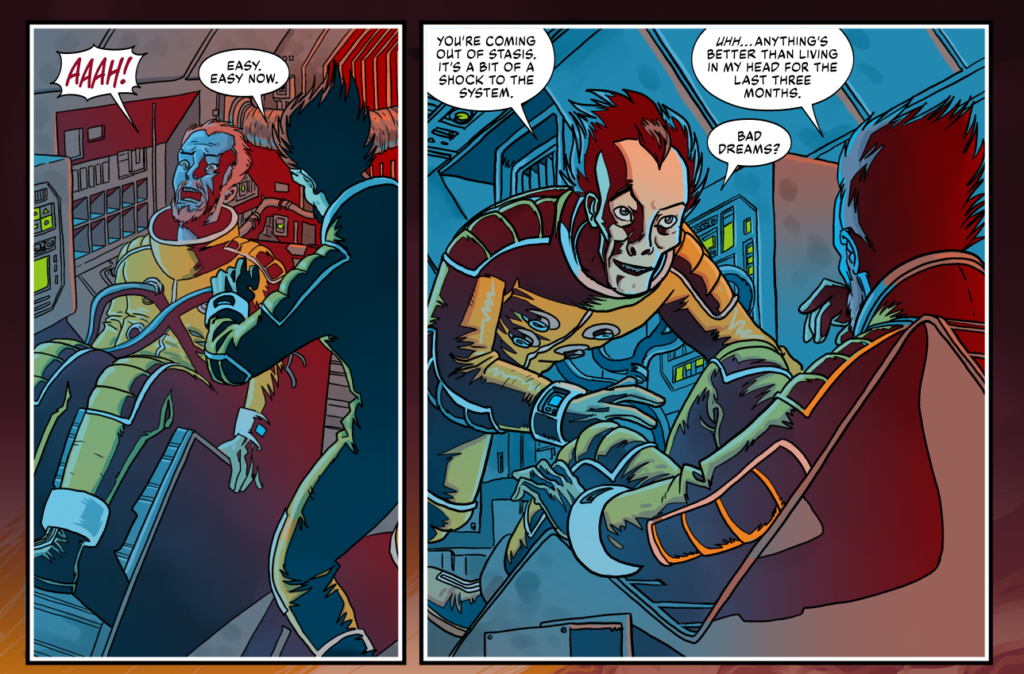
.
You’ve certainly come an awful long way with Scarlet Traces – although it’s been a long and winding road to get here! Does it feel like 2000 AD is rather a natural home for the series now?
IE: Very much so. Matt (D’israeli) and I have been able to tell the story we want at our own pace rather than if it had been an American-style series or mini-series, if anything, it’s analogous to a television series versus a movie.
As well as the primary storyline, we’ve been able to take time to give secondary and even tertiary characters a chance to shine. They’re not just ‘walk-on’ parts, they have an inner life and add a richness and context to the story than if you just focused on the heroes all the time.
There’s certainly a huge mythology to Scarlet Traces, going way beyond the ideas of the steampunky original that took Wells’ ideas of the Martian invasion and expanded on them in the very first Scarlet Traces. You’ve gone from a relatively small-scale, pretty self-contained murder mystery with a twist in Scarlet Traces, all the way through to the current series, which certainly appears, after seeing the first episode, to be taking things all the way to Jupiter.
But one thing all the way through Scarlet Traces has been the incredible world‑building going on – you took the basis from Wells’ original and have just built and built on it all – the pair of you. Although, no doubt, Matt’s been the one doing all the donkey work on it?
IE: Matt and I will do a lot of groundwork before I put pen to paper. I’ll outline the broad concepts, where the story’s going, how I’d like to get there, some set pieces that I’d like to include and Matt will come back with his ideas and in-fill the details on some of my broad strokes.
I’ll also send Matt links with photo reference for the look of ships, characters, environments etc. They’re more to give him an idea of the look or capture a mood rather than anything specific. They’re a starting point which he’ll then take and run with in his own inimitable fashion. Occasionally I’ll ask for specific things, such as in the last series we had a bomb hidden in an old Co-Op van which I’d remembered seeing as kid. It was just a whim but I’ve since had several people get in touch saying, ‘I remember those!’
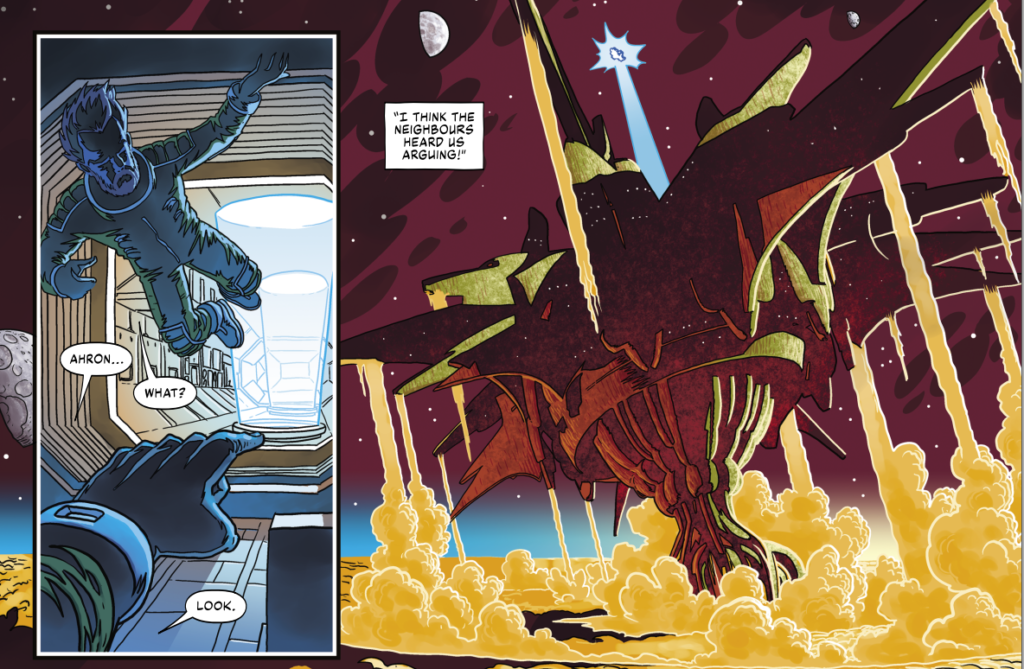
.
Matt – how is Ian to work with on this? Lots of vague, ‘And here I want the sky full of Jovian warships, all completely unique and looking like nothing we’ve ever seen before,’ sort of instructions?
D’ISRAELI: Actually, no – Ian will talk over the broad concepts with me and we’ll set parameters – so he sets the framework, which is the bit I’d find really difficult, and I fill in the details, which is much more my kind of thing.
Ian’s really pretty specific – his scripts come littered with hyperlinks to photo reference! So he’ll often specify a particular real-life car or plane or building as a starting point that I can build on. If I remember rightly, the instructions for the Jovian warships was “organic-looking, a cross between a giant jellyfish and a squid,” which is a great starting point, plenty to work with but not so specific as to stifle creativity.
Digression: to quickly give me the look of a new character, Ian will often refer to a specific actor or celebrity, confident that my likenesses are so lousy that we’ll never have image rights issues 🙂
IE: We’ve been working together for so long that we’re like an old married couple or like an old showbiz double act! We’re the Morecambe and Wise of comics! Thinking about it, I think next year marks the 20th anniversary of us working on Scarlet Traces together!
D’ISRAELI: Yes, and we’ve been working together for nearly 30 years now, so it’s kind of grown up organically. Definitely like an old married couple at this point.
20 years & 30 years! We shall be arranging street parties and a big cake!
Has it been something that’s been intricately planned between the pair of you or has it all evolved rather more organically?
IE: A little from column A, and little from column B!
Finally, when it comes to Scarlet Traces, do you have a definite plan for the course of the storyline, the beginning, middle, end all mapped out, or is it slightly less fixed than that? And where are we right now in the grand scheme of the tale?
IE: This story will pretty much draw to a close the one that began way back in the first-ever series, however because we’ve established such an expansive universe, there are more stories to tell (they’re already in the works in fact) so we’re not done yet!
And with that, Mr Ian Edginton left the building, muttering something about the fact that in 30 years of this artistic marriage, he’s never once had flowers from his artist.
Which left D’Israeli and me to chat over the styles and processes involved in this latest series of Scarlet Traces, and just how much fun it was to get to go all psychedelic on us in episode one, a bit like this…
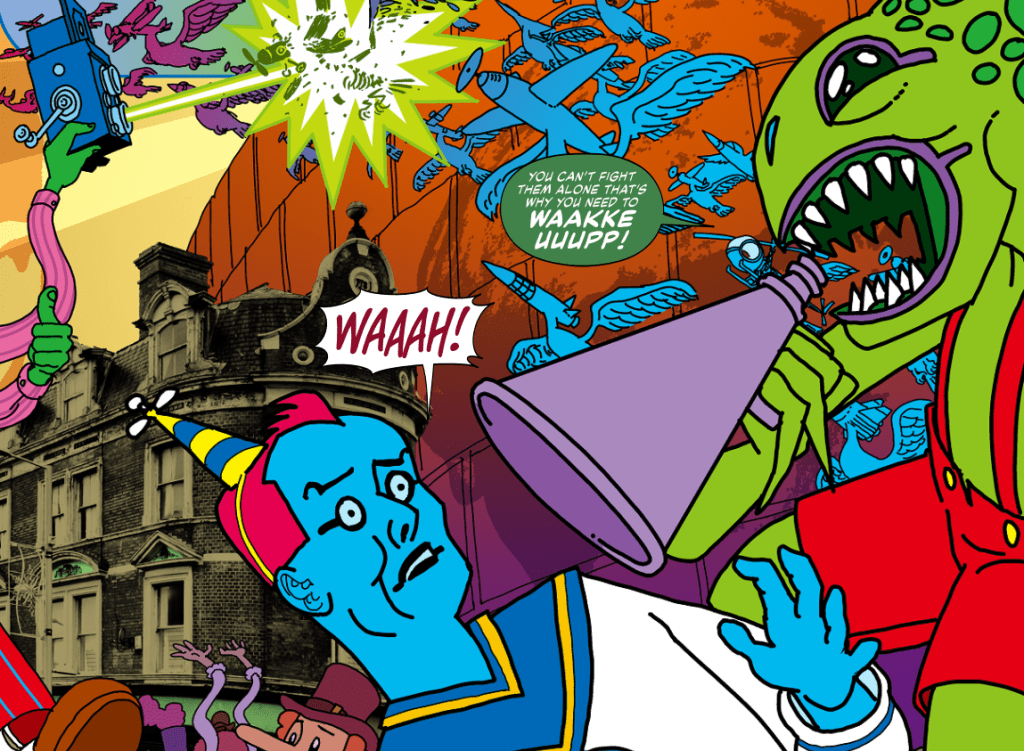
.
Matt, as far as the art on this first episode of Storm Front – there’s a huge mix of styles going on in here, with a spectacular bit of Yellow Submarine-esque psychedelia going on. Was that as much fun as it looked?
D’ISRAELI: Hell, yes. The pages leading up to that were also really fun – starting out in the Cold War painted style and then slowly flattening out the colour as we get more into the psychedelic stuff. I re-watcheded Yellow Submarine and was really taken by the use of photographic backgrounds in the Eleanor Rigby sequence, so I went into Nottingham with my camera and hunted out some suitable architecture. Luckily we still have a few good Victorian buildings left! Also I got to write off a DVD of Yellow Submarine as a business expense. I love my job.
Storm Front refers back to stuff from the Cold War stories, so I’ve been trying to match the art styles in those scenes. Look out for a page that looks like it’s drawn in pencil on coloured paper!
Now, with all the different styles in use, is there a different process with each?
D’ISRAELI: Not as much as you might expect. To explain, I’ve worked digitally for… hellfire, it’ll be 25 years next May. I work on a big Wacom Cintiq drawing tablet/display and everything’s drawn and coloured in Clip Studio Paint (née Manga Studio). My process is akin to working on paper – rough layout, rough pencils, pencils, inks, colour, except all done virtually. That process stays pretty much the same for everything I do, except the collage process on Stickleback.
There are two main ways I vary the look of the pages; one is to change the drawing – so using that distinctive early-70’s John Burns/Gerry Haylock coloured block shadows style, I end up leaving big chunks of shadow blank when I’m inking, whereas with the Cold War painted style I was drawing in everything and painting shadows over the top afterwards. The other way is to change the level of modelling I add when I’m doing the colouring; so with Cold War I was doing this highly-rendered 3D-looking “painted” colouring, whereas Home Front/Storm Front benefits from a cleaner look.
Again, if you look at part 1 of Storm Front, you can see the effect of just progressively simplifying the colour over the first three pages; I was pulling a couple of little drawing tricks, like exaggerating the perspective as things get stranger, but most of the progression into the psychedelic sequence comes just from leaving out modelling in the colouring.
And Matt has sent over the process images for the stunning psychedelic double-pager that dominates this first episode, a true feast fro the eyes from first idea to finished image…
D’ISRAELI: All stages completed in Clip Studio Paint, with this first rough being where I block out the composition and make sure all the main elements are included.
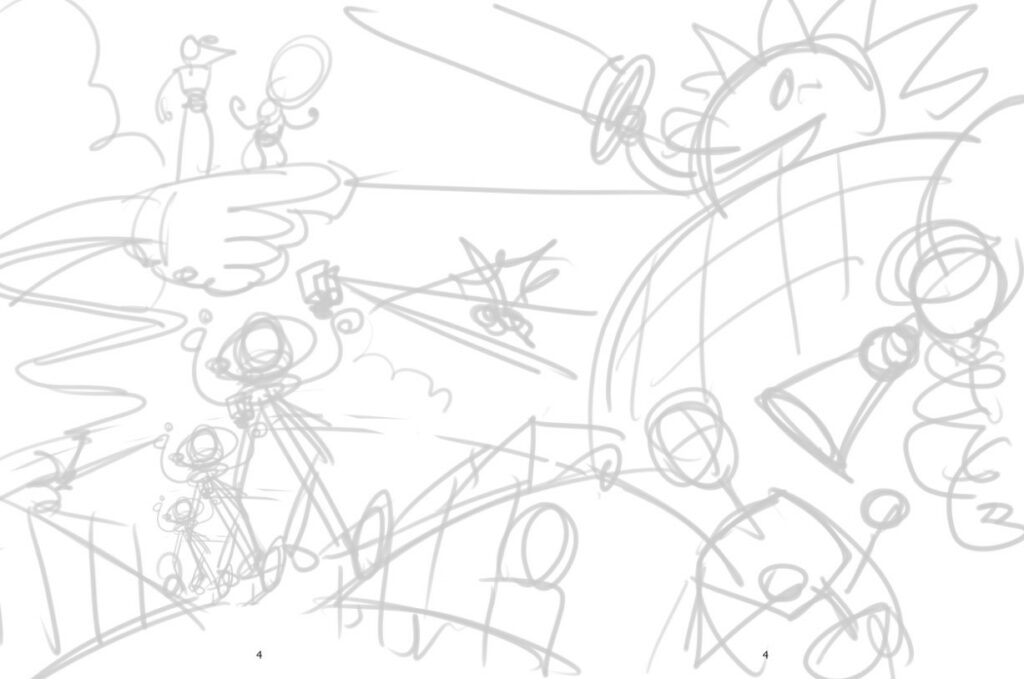
.
D’ISRAELI: Stage 2 -Rough Pencils – establishing correct scale and proportions of all the elements. I’m trying to make sure I’ve got the “backbone” of the drawing set up right – do that and the rest of the drawing falls into place. I also add reference elements at this stage – here I’ve dropped in the photos that will make up part of the background, though I’m not masking them properly yet. (At this stage, I sent a copy of the spread to Tharg-in-Residence Matt Smith and Ian, partly to make sure I hadn’t missed anything out, and partly because I was so far out of my stylistic comfort zone and wanted reassurance!)
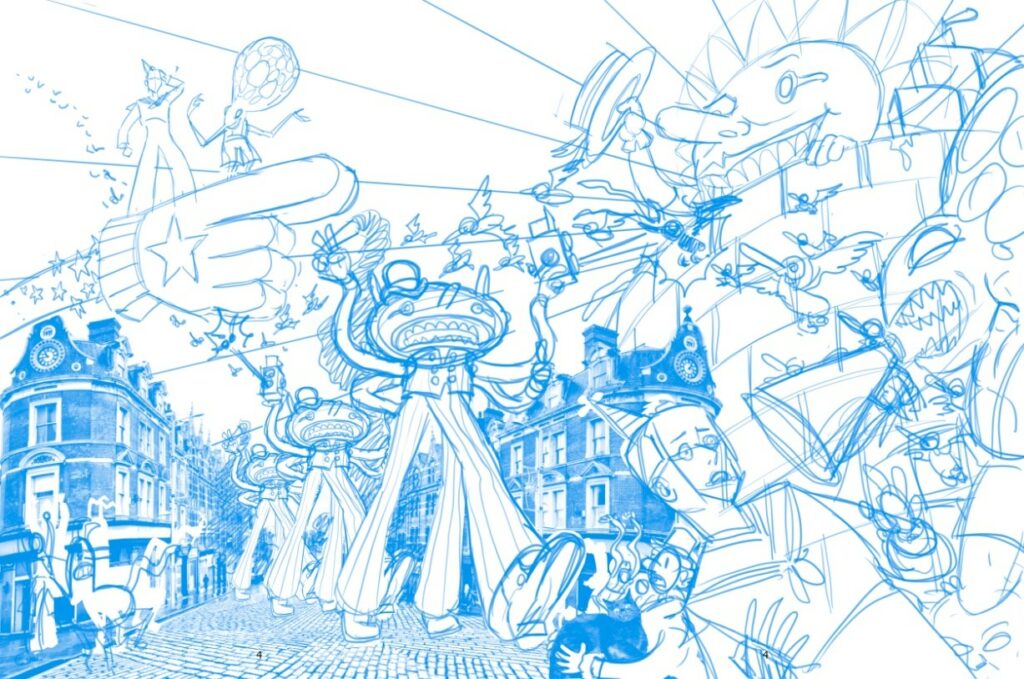
.
D’ISRAELI: Stage 3 – Pencils – I add detail to all the figures and important elements. I often don’t bother to pencil background elements – generally, no one notices if you add an extra window to a house in the background, but everyone will notice if you give a main character an extra eye!
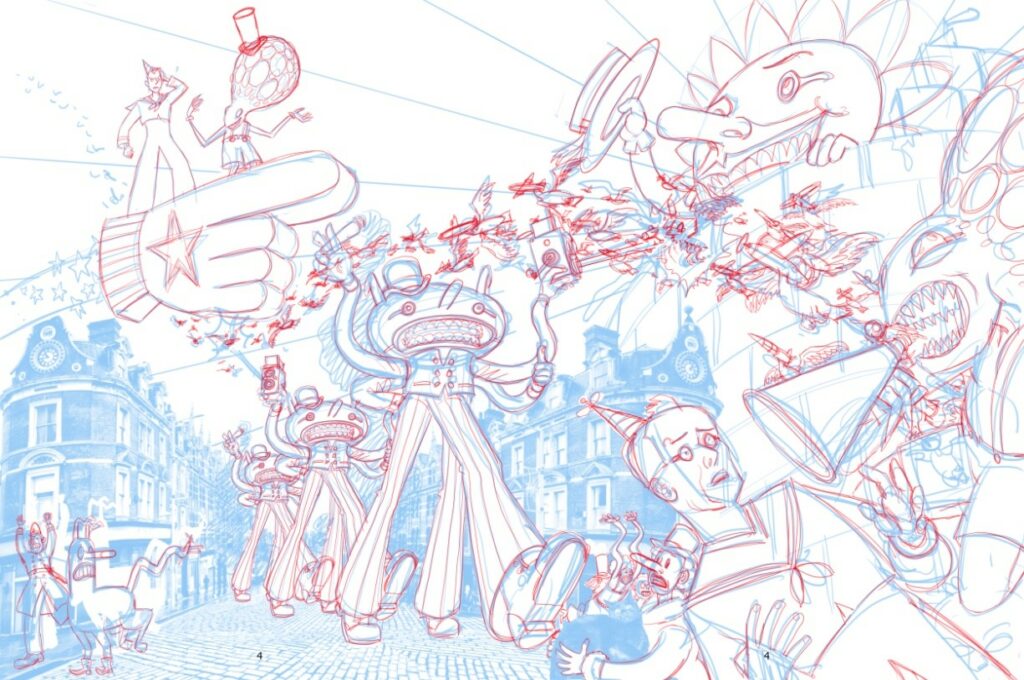
.
D’ISRAELI: Stage 4 – Inks – usually I use a flexible “pen” (that gives a wider line the more pressure you apply) for inking, but in this case, I wanted to imitate the fixed lines used in the animated movie Yellow Submarine, so I used three fixed widths of line to ink the spread, heavier lines for closer elements, lighter lines for more distant ones. Note that because I draw digitally, I can draw coloured outlines directly at the inking stage. If I were working on paper, I’d either have to do the coloured outlines on overlays, or draw it all in black on the main drawing and then cut out the outlines in Photoshop after scanning in.
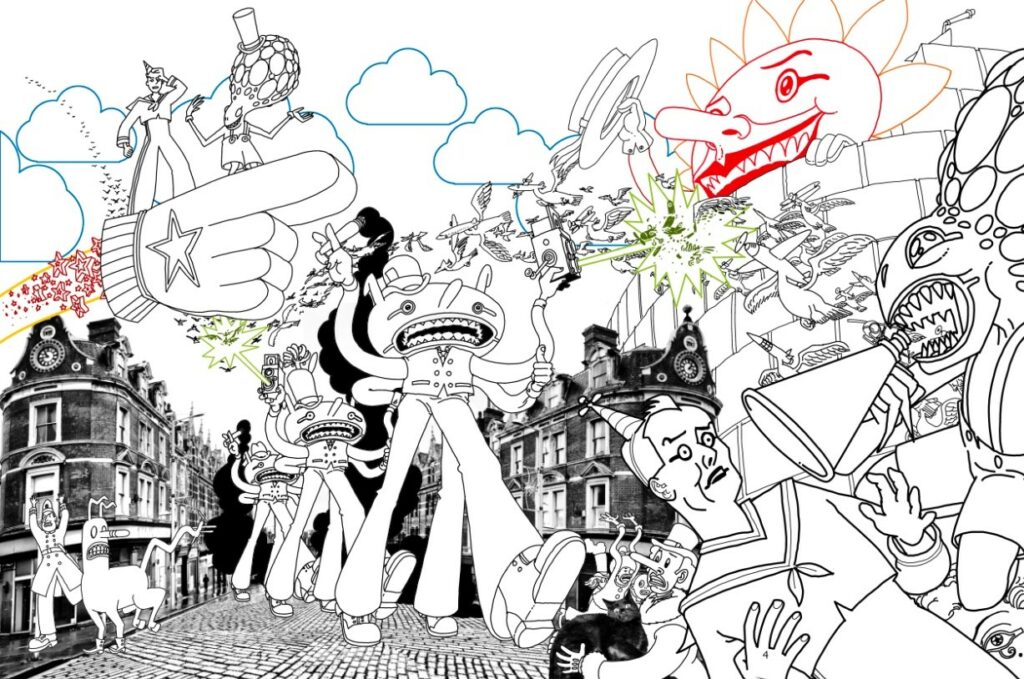
.
D’ISRAELI: Stage 5 – Colour – normally, there would be several steps to this, starting with adding flat colour with the paint bucket tool and then placing highlights and shadows on top with brushes. However, since I want a flat, animated-movie-style look, the first flat-colour pass was pretty much the whole job, except for adding a few subtle gradients here and there.
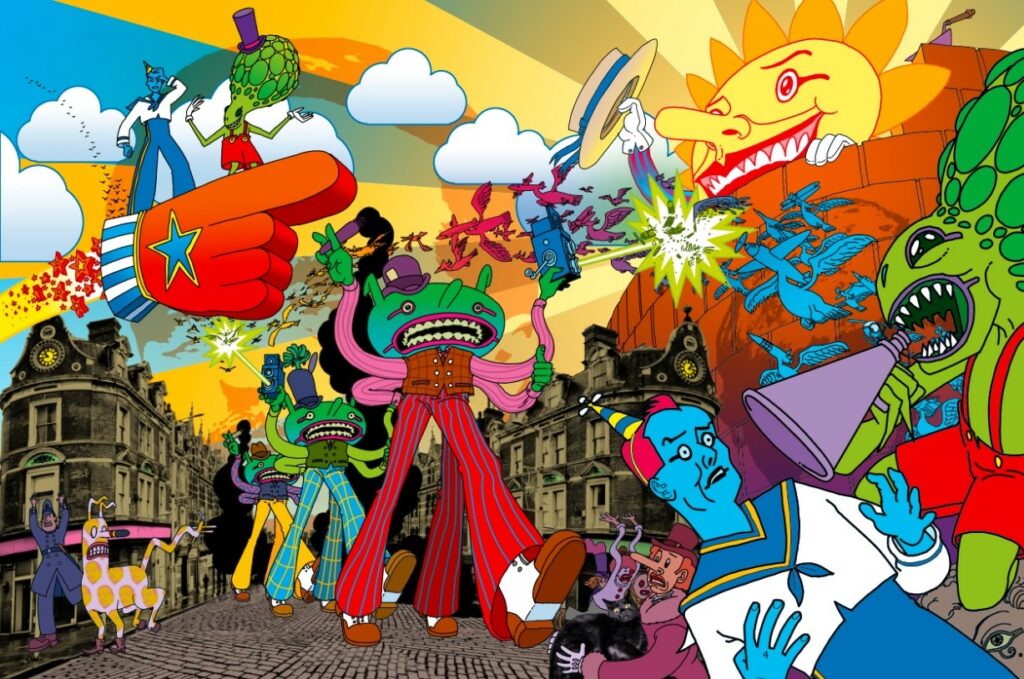
.
And that’s where we left it, with Matt heading after Ian, leaving the building, saying something about having to pick up some flowers.
Thank you to both Ian and Matt for all the details on the new series of Scarlet Traces, Storm Front. You can catch it, along with another four continuing stories and two very special one-off strips, in 2000 AD Prog 2250 – available on 22 September from wherever thrill-power is sold, including the 2000 AD web shop – just look for the stunning cover of Judge Dredd by the legend that is Mike McMahon!
